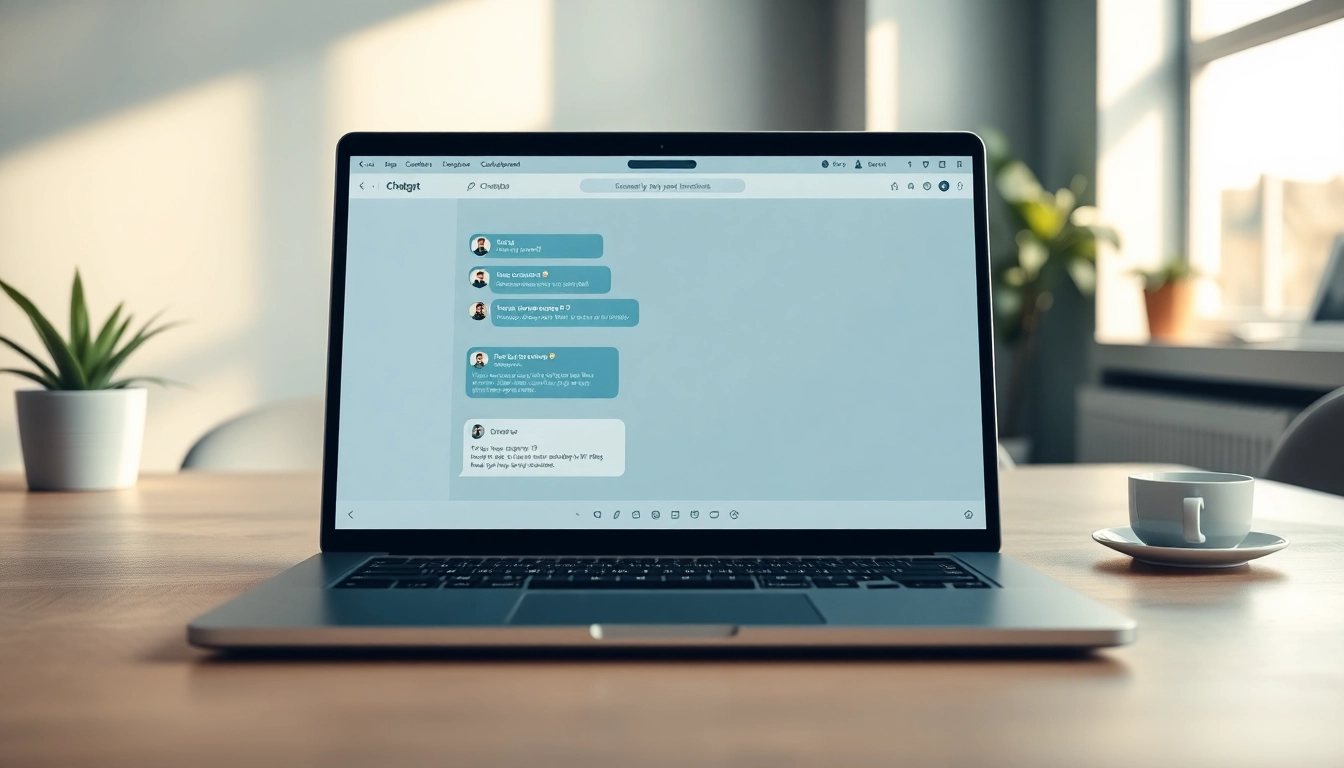Understanding the chatgpt Chatbot: Basics and Benefits
What is a chatgpt Chatbot?
The term chatgpt chatbot refers to an intelligent conversational agent that leverages OpenAI’s Generative Pre-trained Transformer (GPT) technology. By utilizing machine learning algorithms and vast datasets, chatgpt chatbots are designed to engage users in human-like conversations, providing responsive and contextually relevant interactions. These chatbots can comprehend natural language, generate human-like responses, and facilitate a wide range of tasks, from customer service inquiries to personal assistance.
Key Advantages of Using chatgpt Chatbots
Implementing a chatgpt chatbot can significantly enhance operational efficiency and customer satisfaction. Here are some of the vital advantages:
- 24/7 Availability: Unlike human agents, chatgpt chatbots can operate around the clock, ensuring that customers receive assistance whenever they need it.
- Scalability: These chatbots can handle a large volume of inquiries simultaneously, allowing businesses to scale their customer support without proportional increases in costs.
- Consistency: Chatgpt chatbots provide uniform responses to customer queries, minimizing discrepancies and ensuring brand reliability.
- Cost-Effectiveness: By automating routine inquiries, businesses can redirect human resources towards more complex tasks, thereby optimizing labor costs.
- Data Insights: Using chatgpt chatbots enables businesses to collect valuable data on customer preferences and behaviors, which can inform strategies and lead to improved service offerings.
Common Use Cases for chatgpt Chatbots
chatgpt chatbots can be utilized in various sectors to automate tasks and enhance user experiences. Some common use cases include:
- Customer Support: Automated assistance with common inquiries such as order status, account management, and troubleshooting.
- Lead Generation: Engaging website visitors in conversation to gather contact information and qualify leads.
- E-commerce: Assisting customers with shopping by providing product recommendations and facilitating transactions.
- Personal Assistance: Helping users manage schedules, reminders, or personal information efficiently.
- Education: Offering tutoring and educational support through interactive question-and-answer sessions.
How to Implement a chatgpt Chatbot in Your Business
Choosing the Right Platform for chatgpt Chatbots
When selecting a platform for deploying a chatgpt chatbot, businesses should evaluate several factors, including ease of integration, scalability, and the availability of customization options. Popular platforms include:
- Dialogflow: Google’s natural language understanding platform caters to developers looking to build a conversational interface.
- Microsoft Bot Framework: An extensive toolkit for developing, testing, and deploying chatbots across multiple channels.
- Chatbot.com: A user-friendly option designed for businesses looking for quick deployment without extensive technical know-how.
- ManyChat: Targeted at e-commerce and marketing, allowing businesses to automate customer interactions on platforms like Facebook Messenger.
Step-by-Step Integration Process
Integrating a chatgpt chatbot into your business involves several essential steps:
- Define Objectives: Outline the specific goals you want your chatbot to achieve, such as improving customer service or increasing sales.
- Select a Platform: Based on the previously discussed criteria, choose the platform that best fits your needs.
- Design Conversational Flow: Map out the interaction paths your chatbot will take with users, ensuring a logical progression.
- Develop and Train the Bot: Use the chosen platform’s tools to create your chatbot, training it on relevant data to enhance its conversational capabilities.
- Testing: Conduct thorough testing to identify any bugs or areas of improvement before the public launch.
- Deploy: Launch the chatbot on your desired channels, such as your website, mobile app, or social media platforms.
- Monitor and Optimize: After deployment, continuously monitor the chatbot’s performance and make adjustments as needed.
Best Practices for Effective Deployment
To maximize the effectiveness of your chatgpt chatbot, consider the following best practices:
- Create Clear Objectives: Set measurable goals to assess the chatbot’s performance from the beginning.
- Prioritize User Experience: Focus on designing a seamless interaction that minimizes friction for users.
- Provide Fallback Options: Ensure users can easily connect with a human representative when the chatbot cannot resolve inquiries.
- Regular Updates: Keep the chatbot updated with the latest information, products, and services to maintain relevance.
- Solicit Feedback: Encourage users to provide input on their experiences, which can inform future improvements.
Optimizing the chatgpt Chatbot for Better User Experience
Designing Engaging Conversation Flows
Engaging conversation flows are crucial for ensuring that users remain interested and satisfied during interactions with a chatgpt chatbot. To achieve this:
- Use Natural Language: Employ language that reflects how users naturally communicate to create a more relatable experience.
- Incorporate Multimedia: Utilize images, buttons, and links to enhance interactions and provide more information succinctly.
- Segment Interactions: Break down complex inquiries into simpler questions to guide users through the conversation effectively.
Utilizing User Feedback for Improvements
Feedback from users is a goldmine of insights that can drive continuous improvement. Businesses can take the following steps to leverage feedback:
- Implement Feedback Loops: Regularly collect and review feedback to identify patterns and common pain points.
- Conduct A/B Testing: Experiment with different conversational scripts or features and analyze which versions yield better engagement.
- Create a User Community: Foster a community for users to share their experiences and suggestions openly.
Integrating Personalization Features
Personalization can significantly enhance user satisfaction and engagement levels. Here are some strategies to integrate personalization into your chatgpt chatbot:
- Personalized Greetings: Address users by name and tailor introductions based on previous interactions.
- Custom Recommendations: Analyze user history and preferences to suggest products or services that they may find valuable.
- User Profiles: Allow users to create profiles, storing preferences and previous conversations for a more tailored experience in future interactions.
Measuring the Success of Your chatgpt Chatbot
Key Performance Indicators to Track
Measuring the success of a chatgpt chatbot involves tracking several key performance indicators (KPIs). Important KPIs include:
- Response Time: The average time taken by the chatbot to respond to user inquiries.
- Completion Rate: The percentage of interactions that result in the successful completion of user objectives.
- Customer Satisfaction Score: Feedback from users on their overall experience with the chatbot.
- Engagement Metrics: Metrics such as the number of messages exchanged per interaction and daily user engagement levels.
Analyzing User Engagement Metrics
By analyzing user engagement metrics, businesses can gain valuable insights into how well their chatbot is performing:
- Utilization Rate: Measure how often users interact with the chatbot compared to the total number of visitors.
- Drop-off Rates: Identify points in conversations where users abandon interactions to pinpoint areas for improvement.
- Time of Engagement: Understand when users are most likely to engage with the chatbot to optimize its availability during peak times.
Iterating Based on Performance Data
Continuous improvement is key to maintaining an effective chatgpt chatbot. Businesses should follow a structured approach to iteration:
- Regular Reviews: Conduct regular performance reviews, analyzing data to measure success against defined goals.
- Adapt Strategies: Be prepared to change strategies based on data insights, incorporating new trends or responding to user needs.
- Test and Implement: Develop a cycle of testing new features, gathering feedback, and implementing necessary changes to continually enhance the user experience.
Future Trends for chatgpt Chatbots
Advancements in AI and Natural Language Processing
As AI and natural language processing (NLP) technologies continue to evolve, chatgpt chatbots will become increasingly sophisticated. Key advancements include:
- Context Awareness: Future chatbots will better understand context from previous interactions, enabling more relevant and intuitive responses.
- Emotion Recognition: Enhanced capabilities in discerning user emotions based on language tone and word choice could improve interactions significantly.
- Multi-Lingual Support: Advanced language models will enable chatbots to interact fluently in multiple languages, broadening their applicability globally.
Emerging Features to Watch For
As technology progresses, several emerging features are likely to shape the future of chatgpt chatbots:
- Voice Integration: Increased compatibility with voice assistants will allow users to engage with chatbots through spoken language.
- Integration with IoT: chatgpt chatbots could synchronize with smart devices, offering control and monitoring capabilities under one interface.
- Deeper Insights through AI: AI will move beyond just chat responses, providing predictive analysis and sophisticated customer insights for more proactive engagement.
Staying Ahead of the Competition with chatgpt Chatbots
Adaptability will be crucial for businesses wishing to maintain a competitive edge with chatgpt chatbots. Companies should:
- Stay Informed: Keep abreast of the latest developments in AI and machine learning to implement cutting-edge features early
- Iterate Innovatively: Foster a culture of innovation, regularly revising and enhancing chatbot capabilities based on industry trends.
- Expand Horizons: As competition grows, consider expanding the chatbot’s capabilities beyond basic inquiries to offer holistic assistance relevant to your industry.



